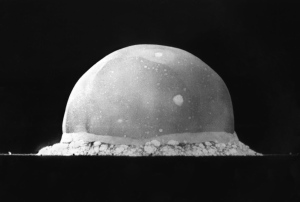Glenn Carroll
PLUTONIUM.

It’s the problem child of the Atomic Age. The first-born from the union of Uranium with man. Gone forth and multiplied – well, proliferated. The fearsome heart of atomic bombs. And now, 34 tons of our precious plutonium is finding its way back home to the Savannah River Site.
Imagine!
For a brief moment, we entertained the grandest of impulses and contemplated reuniting plutonium with the mother fluid from which it was first extracted. I’m referring, of course, to the 35 million gallons of high-level liquid radioactive waste which waits in 50-year-old underground tanks (and occasionally leaks).
REUNITE PLUTONIUM and its related nuclear waste in the immobilization process and you do much to alleviate two currently malignant situations. Plutonium is an ultra-slow radioactivity emitter, and poses no immediate threat to any would-be thief. But only a few pounds of plutonium can be easily made into a bomb, so no slip-ups at all are allowed to the nuclear baby-sitter.

It would be better to return plutonium to the care of the radioactive solvents from which it was taken. The ferociously hot nuclear waste, dangerously mobile if it escapes into the environment, can be solidified into two-ton, glass logs surrounding plutonium canisters to completely safeguard the plutonium from all would-be molesters.
That is nuclear waste management and plutonium security in one righteous jobs program!
Imagine.
REGRETTABLY, the fine notion of immobilization gave way to a far more elaborate proposal – to run plutonium back through the mill and generate yet more hot liquids. Nicknamed “MOX,” the plan called for 34 tons of plutonium returning to Savannah River Site to be fashioned into an untested plutonium nuclear-power plant fuel. MOX’s claim to the plutonium seems to be weakening though as the United States drags a reluctant Russia toward an unprecedented partnership in an ill-advised attempt to harness leftover Cold War fuel to the badly sagging nuclear-power industry.
It’s too early to call the outcome of the plutonium toss-up, but the grandiose concept of MOX plutonium nuclear fuel has been overtaken by a final and supremely sinister suggestion which has emerged for the SRS-bound plutonium. Process it and make it back into “The Bomb!”
Imagine.
The United States, the way-out-front leader of the free world, whose military and nuclear strength knows no peer, has a compelling desire to set up shop to make atomic bombs again. And how can the selective eye fail to settle on Savannah River Site? Glittering crown jewel of the nation’s nuclear-weapons complex with thousands of highly trained Cold War heroes, masters in the handling of plutonium – and with the added bonus of 34 tons of plutonium in stock!
Imagine.
THE DEPARTMENT OF Energy operated its only other plutonium pit facility at Rocky Flats near Denver for 37 years but production was halted because the facility could not be operated within safety and environmental regulations. Exposures to plutonium, beryllium, and other toxins in the work place resulted in elevated levels of cancer, lung disease and other ailments among workers at the Rocky Flats plant.
One worker can be expected to die for every 4.5 years of plutonium pit plant operations, according to the three-volume, 1,000-page Draft Environmental Impact Statement for Modern Pit Facility issued by the Department of Energy.

Imagine.
Thirty-four tons of plutonium are coming to Savannah River Site. A few pounds can make a bomb to vaporize tens of thousands of sons and daughters, fathers and mothers, brothers and sisters in the winking of an eye.
PEOPLE WILL converge from many points on the map and from many points of view to discuss the fate of 34 tons of plutonium in North Augusta this Monday night.
Plutonium. Our first-born child of the Atomic Age. God bless the child. And God bless the people who care for the child.
Imagine.
(Editor’s note: The writer is coordinator of Georgians Against Nuclear Energy, or GANE. GANE opposes construction authorization for the MOX facility before the U.S. Nuclear Regulatory Commission Atomic Safety and Licensing Board.)
From the Saturday, July 05, 2003 edition of the Augusta Chronicle
